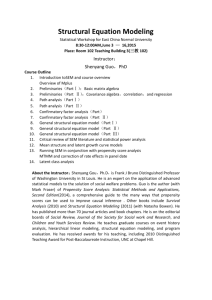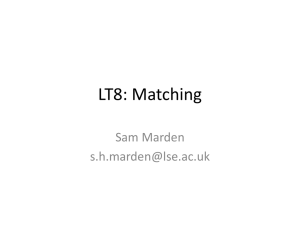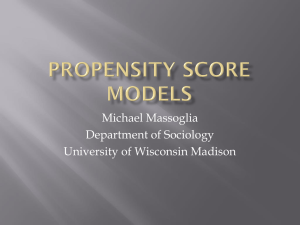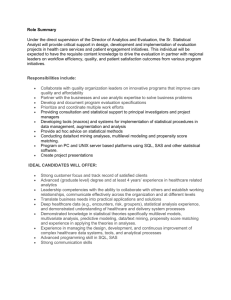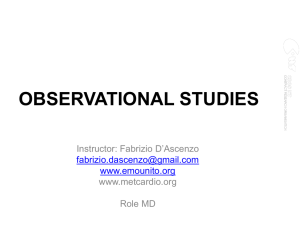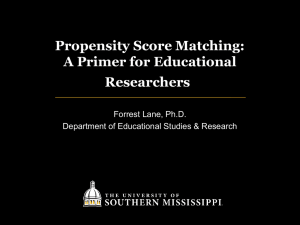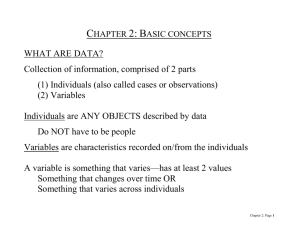References Austin, P. C. (2008). A critical appraisal of propensity
advertisement
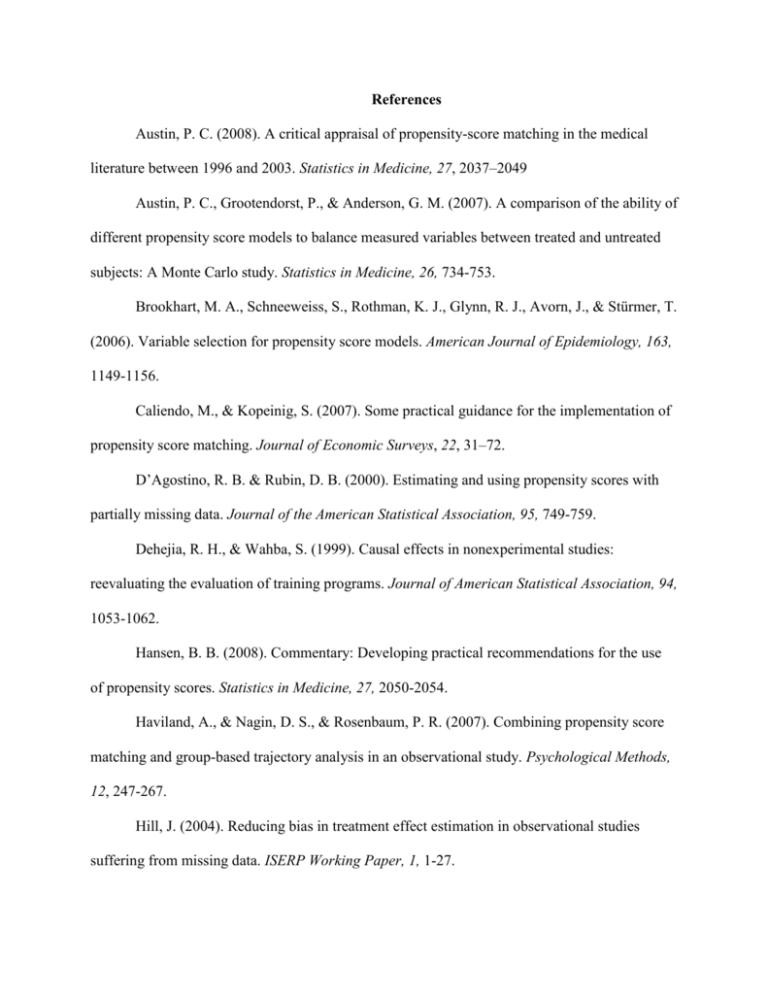
References Austin, P. C. (2008). A critical appraisal of propensity-score matching in the medical literature between 1996 and 2003. Statistics in Medicine, 27, 2037–2049 Austin, P. C., Grootendorst, P., & Anderson, G. M. (2007). A comparison of the ability of different propensity score models to balance measured variables between treated and untreated subjects: A Monte Carlo study. Statistics in Medicine, 26, 734-753. Brookhart, M. A., Schneeweiss, S., Rothman, K. J., Glynn, R. J., Avorn, J., & Stürmer, T. (2006). Variable selection for propensity score models. American Journal of Epidemiology, 163, 1149-1156. Caliendo, M., & Kopeinig, S. (2007). Some practical guidance for the implementation of propensity score matching. Journal of Economic Surveys, 22, 31–72. D’Agostino, R. B. & Rubin, D. B. (2000). Estimating and using propensity scores with partially missing data. Journal of the American Statistical Association, 95, 749-759. Dehejia, R. H., & Wahba, S. (1999). Causal effects in nonexperimental studies: reevaluating the evaluation of training programs. Journal of American Statistical Association, 94, 1053-1062. Hansen, B. B. (2008). Commentary: Developing practical recommendations for the use of propensity scores. Statistics in Medicine, 27, 2050-2054. Haviland, A., & Nagin, D. S., & Rosenbaum, P. R. (2007). Combining propensity score matching and group-based trajectory analysis in an observational study. Psychological Methods, 12, 247-267. Hill, J. (2004). Reducing bias in treatment effect estimation in observational studies suffering from missing data. ISERP Working Paper, 1, 1-27. Hill, J. (2008). Commentary: Developing practical recommendations for the use of propensity scores. Statistics in Medicine, 27, 2055-2061. Hill, J., & Reiter, J. P. (2006). Interval estimation for treatment effects using propensity score matching. Statistics in Medicine, 25, 2230-2256. Hirano, K., Imbens, G. W., & Ridder, G. (2003). Efficient estimation of average treatment effects using the estimated propensity score. Econometrica, 71, 1161-1189. Ho, D. E., Imai, K., King, G., & Stuart, E. A. (2004). Matchit: Matching as nonparametric preprocessing for parametric causal inference. Obtained online at http://gking.harvard.edu/matchit/ Ho, D. E., Imai, K., King, G., & Stuart, E. A. (2007). Matching as nonparametric preprocessing for reducing model dependence in parametric causal inference. Political Analysis, 15, 199–236. Hong, G., & Raudenbush, S. W. (2006). Evaluating kindergarten retention policy: a case study of causal inference for multi-level observational data. Seminar Series Paper, Department of Statistics, University of Chicago. Hong, G., & Yu, B. (2008). Effects of kindergarten retention on children’s socialemotional development: An application of propensity score method to multivariate multi-level data. Special Section on New Methods in Developmental Psychology, 44(2), 407-421. Imai, K. & Van Dyk, D. A. (2004). Causal inference with general treatment regimes: generalizing the propensity score. Journal of the American Statistical Association, 99, 854-866. Imbens, G. W. (2000). The role of the propensity score in estimating dose-response functions. Biometrika, 87, 706-710. Kaplan, D. (1999). An extension of the propensity score adjustment method for the analysis of group differences in MIMIC models. Multivariate Behavioral Research, 34, 467-492. Kim, J. and Seltzer, M. (2007) Causal Inference in Multilevel Settings in which Selection Process Vary across Schools. Working Paper 708, Center for the Study of Evaluation (CSE): Los Angeles. Luellen, J. K., Shadish, W. R., & Clark, M. H. (2005). Propensity scores: An introduction and experimental test. Evaluation Review, 29, 530-558. Lunceford, J. K., & Davidian, M. (2004). Stratification and weighting via the propensity score in estimation of causal treatment effects: a comparative study. Statistics in Medicine, 23, 2937-2960. McCaffrey, D. F., Ridgeway, G., & Morral, A. R. (2004). Propensity score estimation with boosted regression for evaluating causal effects in observational studies. Psychological Methods, 9, 403-425. Ming, K., & Rosenbaum, P. R. (2000). Substantial gains in bias reduction from matching with a variable number of controls. Biometrics, 56, 118-124. Ming, K., & Rosenbaum, P. R. (2001). A note on optimal matching with variable controls using the assignment algorithm. Journal of Computational and Graphical Statistics, 10, 455-463. Pearl, J. (2000). Causality: Models, Reasoning, and Inference. Cambridge, UK: Cambridge University Press. Rosenbaum, P. R. (1989). Optimal matching for observational studies. Journal of the American Statistical Association, 84, 1024-1032. Rosenbaum, P. R, & Rubin, D. B. (1983). The central role of propensity scores in observational studies for causal effects. Biometrika, 70, 41-55. Rosenbaum, P. R. & Rubin, D. B. (1984). Reducing bias in observational studies using subclassification on the propensity score. Journal of the American Statistical Association, 70, 516-524. Rubin, D. B. (1997). Estimating causal effects from large data sets using propensity scores. Annals of Internal Medicine, 127, 757-763. Rubin, D. B. (2005). Causal inference using potential outcomes: design, modeling, decisions. Journal of the American Statistical Association, 100, 322-331. Rubin, D. B. & Thomas, N. (1996). Matching using estimated propensity scores: relating theory to practice. Biometrics, 52, 249-264. Rubin, D. B. & Thomas, N. (2000). Combining propensity score matching with additional adjustments to prognostic covariates. Journal of the American Statistical Association, 95, 573-585. Schafer, J. L., & Kang, J. D. Y. (in press). Average causal effects from observational studies: a practical guide and simulated example. Psychological Methods. Sekhon, J. S. (in press). Multivariate and propensity score matching software with automated balance optimization: The matching package for R. Journal of Statistical Software. Shadish, W. R., Clark, M. H., & Steiner, P. (in press). Can nonrandomized experiments yield accurate answers? A randomized experiment comparing random to nonrandom assignment. Journal of the American Statistical Association. Shah, B. R., Laupacis, A., Hux, J. E., & Austin, P. C. (2005). Propensity score methods gave similar results to traditional regression modeling in observational studies: A systematic review. Journal of Clinical Epidemiology, 58, 550-559. Stuart, E. (in press). Matching methods for causal inference: A review and a look forward. Statistical Science. Stuart, E. A. (2008). Commentary: Developing practical recommendations for the use of propensity scores. Statistics in Medicine, 27, 2062-2065. Stürmer, T., Joshi, M., Glynn, R. J., Avorn, J., Rothman, K., & Schneeweiss, S. (2006). A review of the application of propensity score methods yielded increasing use, advantages in specific settings, but not substantially different estimates compared with conventional multivariable matching methods. Journal of Clinical Epidemiology, 59, 437-447. Stürmer, T., Schneeweiss, S., Brookhart, M. A., Rothman, K. J., Avorn, J., & Glynn, R. J. (2005). Analytic strategies to adjust confounding using exposure propensity scores and disease risk scores: nonsteroidal antiinflammatory drugs and short-term mortality in the elderly. American Journal of Epidemiology ,161, 891-898. Yanovitzky, I., Zanutto, E., & Hornik, R. (2005). Estimating causal effects of public health education campaigns using propensity score methodology. Evaluation and Program Planning, 28, 209-220. Zanutto, E., Lu, B., & Hornik, R. (2005). Using propensity score subclassification for multiple treatment doses to evaluate a national antidrug media campaign. Journal of Behavioral and Educational Statistics, 30, 59-73.
